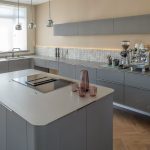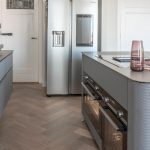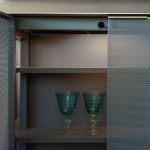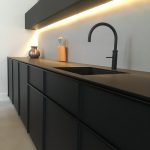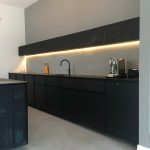————————————————————————————-english below
SPAZIO de nieuwe aluminium keuken
Een keuken is al lange tijd meer dan alleen een ruimte waar de dagelijkse maaltijden worden bereid.
De moderne keuken staat in open verbinding met de woonkamer en is een multifunctionele leefruimte geworden.
Persoonlijke smaak en specifieke wensen spelen een belangrijke rol bij de inrichting van de moderne keuken en steeds vaker wordt bij het betrekken van een nieuwe woning de keuken als eerste aangepast of geheel vervangen.
In de basis zijn ‘alle’ keukens sinds de jaren ’60 identiek, waardoor de ontwerpvrijheid steeds beperkt is gebleven tot cosmetische variatie op de fronten en het aanrechtblad. De bouwwijze met repeterende spaanplaat kastjes is verouderd, niet duurzaam en beperkend. Het draagt bij aan de tendens van de keuken als wegwerpartikel.
Voldoende aanknopingspunten voor de ontwerper om een volledig nieuwe keuken te construeren voor de open leefruimte, met maximale ontwerpvrijheid, innovatief, flexibel en duurzaam.
De nieuwe constructie van Spazio keukens gebruikt de aanwezigheid van een bouwkundige wand en ontleend er zijn stabiliteit aan. Hierdoor kan de constructie licht en eenvoudig blijven.
Slechts het gebruik van 2-dimensionale aluminium frames, gemonteerd in een vrij maatritme, vormen de basis van een Spazio keuken. Tussen de frames wordt de apparatuur en de laden gehangen.
Door het vrije maatritme past de keuken altijd in de gegeven situatie en kunnen grafisch harmonieuze aanzichten worden gerealiseerd, zonder plinten of paspanelen.
De constructie van Spazio is volledig open, met achter en onder de frames toegankelijke vrije ruimte voor alle leidingen en afvoer. Het eiland zweeft boven de vloer, heeft een zelfstandige aluminium constructie en rust op slechts 4 metalen stelvoeten die gezien mogen worden.
De toepassing van plaatmetalen fronten biedt een heel nieuw spectrum aan pure materialen voor de vormgeving van uw keuken. Mogelijk voorzien van perforaties en gebogen fronten voor het realiseren van zachte volumes.
Aluminiumplaat 2mm is de primaire keuze, voorzien van een duurzame poedercoating in elke kleur, of geanodiseerd.
Verder zijn er veel exclusieve opties zoals; blauw staal – roestvrijstaal – verzinkt staal – Cortenstaal – koper – messing – brons – chroom etc. Of bijvoorbeeld het fraaie DeskTop linoleum van Forbo.
Ook massief hout of fineer blijft een mogelijke optie voor de fronten van Spazio keukens.
Als aanrechtblad past dun materiaal zoals aluminium, roestvrijstaal of Arpa Fenix goed bij het ranke ontwerp.
De lichte maar degelijke constructie is demontabel en kan meeverhuizen zonder verlies van kwaliteit. De levensduur van een keuken kan hiermee aanzienlijk verlengd worden, mede door het flexibele concept en de mogelijkheden van aanpassen aan nieuwe omstandigheden. Een Spazio keuken kan als een plooibaar en duurzaam meubelsysteem deel gaan uitmaken van uw inboedel, zodat u na een verhuizing niet ‘opnieuw’ hoeft te beginnen.
Hiermee is Spazio afgestemd op de groter wordende noodzaak van circulair produceren en het beperken van afval.
Tot slot is uw keuken in de eerste plaats een functioneel product. Het dient te voldoen aan de dagelijkse cyclus van het koken met alle ergonomische functies, dus logisch kunnen handelen met korte looplijnen.
Een Spazio keuken verbindt schoonheid aan functionaliteit en duurzaamheid.
Interesse gekregen in zo’n prachtige Spazio keuken van Ben Hoek?
For over half a century, standard modules made from a waste product from the wood industry have been used to build kitchens. Partly because of this unsustainable base, the kitchen has fallen into an atmosphere of disposability. When moving into a new house, the kitchen is often the first to be replaced. Even in the higher end, the chipboard construction is identical but the use of noble materials for the exterior creates a stark contrast with the interior.
With a completely new construction, it becomes possible to break free from the constraints of fixed modules and cosmetic variants to make a coherent whole of the kitchen.
A kitchen as a pliable and durable furniture system. That is the idea.
The new construction of Spazio kitchens uses the presence of a structural wall and derives its stability from it. Only the use of 2-dimensional aluminium frames, assembled in a free dimensional rhythm, form the basis of a Spazio kitchen. Between the frames the appliances and drawers are hung.
This eliminates the usual rear panels, double side panels and bottoms under the drawers of chipboard modules, creating a completely open construction without fitting panels and plinths, with free space behind the frames accessible for all pipes, drains etc.
The island of a Spazio kitchen has a construction made of aluminium cassettes and stands on only 4 solid aluminium adjustable feet, also without the use of plinths.
The use of metal fronts, whether perforated or not, offers a whole new spectrum of unadulterated natural materials for the design of your kitchen.
Aluminium (coloured or anodised) – blue steel – black steel – galvanised steel – copper – brass – bronze – stainless steel, but also wood (veneer) or the attractive DeskTop linoleum are possible options for the fronts of a Spazio kitchen. As a worktop, thin materials such as aluminium, stainless steel or Arpa Fenix fit well with the slender design.
The lightweight but solid construction can be dismantled and moved with you without loss of quality. The lifespan of a kitchen can thus be extended considerably, partly because of its water resistance, its flexible concept and the possibility of adapting to new circumstances, the kitchen can become part of the household contents. Spazio is thus also attuned to the requirements of circular production and waste reduction.
A kitchen is first and foremost a functional product. It should meet the daily cycle of cooking with all its ergonomic functions, i.e. be able to act logically with short walking distances.
A Spazio kitchen is a combination of functionality and beauty and helps make cooking a soothing moment of the day.
